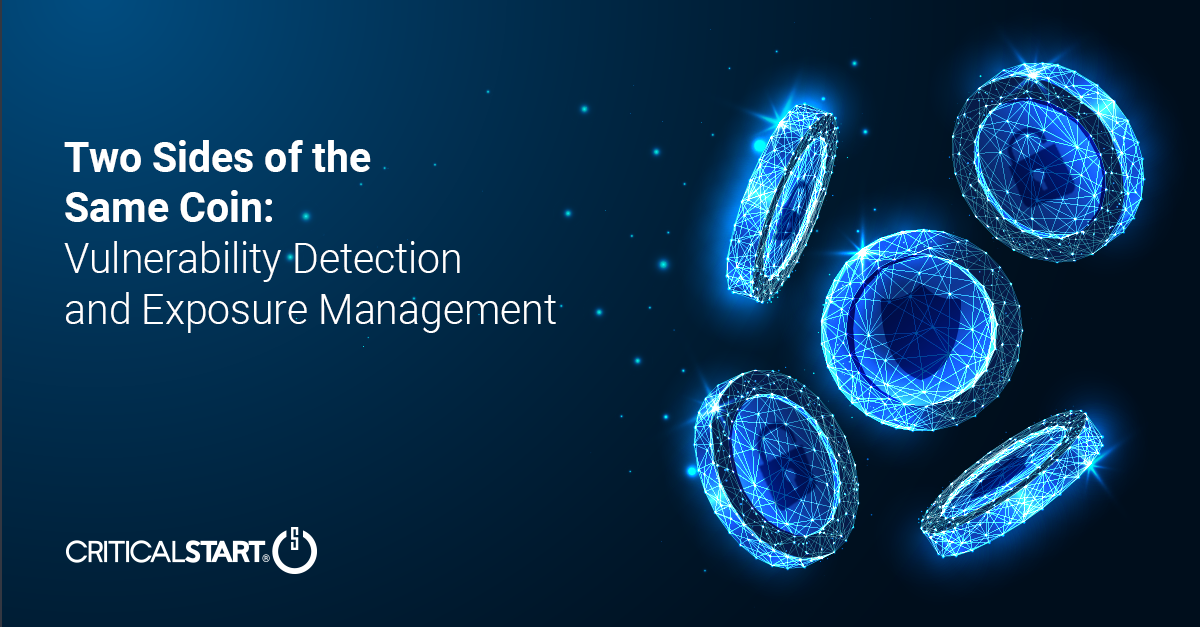Two Sides of the Same Coin: Vulnerability Detection and Exposure Management

Part One of Three: Exposure Management that Drives Tangible Cyber Risk Reduction Outcomes
Those of us in cybersecurity know how challenging and dynamic this field can be. At any moment, evolving threats and vulnerabilities could cripple your organization’s systems, applications, and networks – systems that evolve as fast as the threats that target them. It’s a constant battle, figuring out which systems are most at risk, which vulnerabilities might get used against you, and how to patch before attackers find their way in. Just when you think you have a handle on it, attackers raise the stakes with new ways to weaponize vulnerabilities – including those you might have deprioritized – putting your organization at even greater risk.
Effective risk reduction requires a solid bridge between vulnerability detection and exposure management. These two processes are closely related, but they have different objectives and functions. In this three-part blog series, we will explore:
- How vulnerability detection and exposure management work together to enhance your security posture and reduce your cyber risk.
- Effective strategies for risk reduction beyond specific tools or services.
- A future of exposure management that is built on continuous vulnerability prioritization.
Vulnerability Detection is the Act of Finding What You Have
Vulnerability detection is data – it is “what you have.” By finding and cataloging the weaknesses and flaws that exist in your organization’s systems, applications, and networks, you gain the insights you need to begin the exposure management process. The data you gather includes vulnerabilities that can be exploited by hackers to compromise the confidentiality, integrity, or availability of your data and resources. It gives you a snapshot of the current state of your security posture, showing you the gaps and exposures that need your attention.
The challenge with vulnerability detection often lies in the volume of data produced, especially when performed at scale. The more often you scan, the more data you receive. And it doesn’t help that so many vulnerabilities are considered “high” or “critical” in priority, according to their CVSS scores. Effective prioritization for risk reduction impact requires you to factor vulnerability scores alongside other measures, including asset value, current weaponization or exploitations in the wild, remediation costs, and the potential business impact.
Common Vulnerability Scoring System 101
One of the common ways to identify and measure vulnerabilities is to use the Common Vulnerabilities and Exposures (CVE) system and the Common Vulnerability Scoring System (CVSS). CVE is a standardized list of publicly known vulnerabilities, each assigned a unique identifier and a brief description. CVSS is a numerical score that reflects the severity of a vulnerability, based on several factors such as the attack vector, the impact, and the exploitability.
Exposure Management is the Art of Knowing Your Next Steps
Exposure management is your prioritized vulnerability detection data in action – it is “what you do with what you have.” Through the process of analyzing and prioritizing the vulnerabilities that you detected, you can take appropriate actions to mitigate or remediate what you found. Exposure management is achieved through a combination of methods and frameworks, such as patching, configuration changes, compensating controls, or risk acceptance.
This process, while critical to your security posture, is harder than it might seem and is often ineffective in practice. It requires a deep understanding of rapidly changing operating environments, keeping up with shifting threat landscapes, knowing which assets are at greatest risk (as they constantly change), and assessing the severity and potential impact of each vulnerability. Then you must consider the environment in which each vulnerability exists and align remediation efforts with your business goals, available resources, and risk appetite.
Putting Vulnerability Detection and Exposure Management Together for Cyber Risk Reduction
The end goal of both vulnerability detection and exposure management is risk reduction. By combining “what you have” and “what you do about it”, you can drive change that demonstrably reduces cyber risk. Getting to that point, however, requires having the right tools, people, and processes, all working together, to understand and act upon the operating environment, the threat landscape, and operational goals. Effective risk reduction through vulnerability detection and exposure management means that security, business operations, and IT operations teams must work together, communicating fluidly, and tracking toward a common set of organizational goals.
Cyber risk is the potential loss or damage that you may suffer as a result of a cyberattack or incident.
Cyber risk reduction is the measure of how much you have lowered your exposure and likelihood of being compromised or disrupted by a cyber threat.
So then, how do you know that your strategy is working?
Cyber risk reduction can be measured and articulated using various metrics and indicators, measured regularly, and compared over time, including:
- The number of vulnerabilities remediated between scans
- The actions taken and how they meet risk appetite (i.e., percentage of risks mitigated/fixed vs. accepted)
- Mean time to detection (MTTD) and mean time to remediation (MTTR)
- Remediation percentages by risk score
- Comparison of security posture against that of industry peers
With the right tools, people, and processes in place, you don’t just accelerate risk reduction — you also demonstrate the effectiveness of your security stack, illuminate weaknesses before they become costly blind spots, and justify budget requests for new tools and talent with data.
Be sure to subscribe and follow us on social media so that you don’t miss the next installment of this three-part blog series, where we’ll take a tool-agnostic look into vulnerability prioritization strategies that really work.
RESOURCE CATEGORIES
- Buyer's Guides(1)
- Consumer Education(39)
- Consumer Stories(2)
- Cybersecurity Consulting(4)
- Data Breaches(15)
- Data Privacy(43)
- Incident Response(2)
- Interview(51)
- MDR Services(59)
- MobileSOC(6)
- News(5)
- Press Release(101)
- Research Report(9)
- Security Assessments(2)
- Thought Leadership(19)
- Threat Hunting(3)
- Video(1)
- Vulnerability Disclosure(1)
